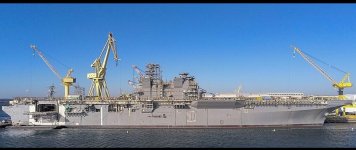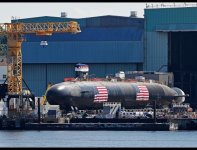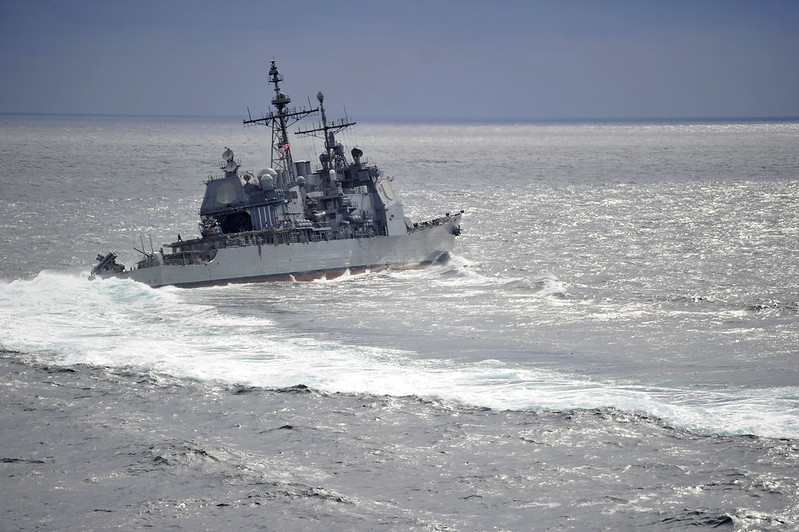View attachment 47379
View attachment 47380
New Ford class carrier and America class amphib assault ship delivering next year.
Higher quality build, more advanced capability.
The USN can project naval power anywhere on the planet
The U.S. Can Afford a Bigger Military. We Just Can’t Build It
America’s industrial base struggles to ramp up defense production while China’s churns out ever more weapons
Updated Dec. 6, 2023
When the Center for Strategic and International Studies
simulated a war between the U.S. and China over Taiwan, the wargame ended with Taiwan still free, at grievous cost. The U.S. loses two aircraft carriers and up to 20 destroyers and cruisers; China sees more than 50 major surface warships sunk.
What looks like a draw, though, becomes a Chinese victory before long. As Eric Labs, a navy analyst for the Congressional Budget Office explains, China can replace lost ships far more quickly. In the past two years, its navy has grown by 17 cruisers and destroyers; it would take the U.S. six years to build the same number under current conditions, he said.
“In terms of industrial competition and shipbuilding, China is where the U.S. was in the early stages of World War II,” Labs said. In the U.S. now, “we just don’t have the industrial capacity to build warships…in large numbers very fast.”
Intensifying security challenges from the western Pacific to Ukraine to the Middle East have fueled debate over whether the U.S. can afford a bigger military. In fact, the more pressing question is whether it can build one—when its principal adversary possesses vast industrial capacity.
U.S. military spending was 3.1% of gross domestic product in the last fiscal year, near the lowest since World War II. Add the $106 billion
President Biden has requested in aid primarily for Ukraine, Israel and Taiwan, and the total would still be less than the 4.6% spent at the peak of Iraq and Afghanistan operations in 2010, never mind the 8.9% in 1968, during the Vietnam War. Healthcare, pensions and interest on the debt
really do menace the nation’s finances; military outlays don’t.
The problem is that even when money’s available, the munitions and weapons are difficult to deliver. In May of 2022, Biden and
Lockheed Martin promised to double production of Javelin antitank missiles by 2024. That has been
pushed back to 2026. The U.S. announced the sale of
Harpoon antiship missiles to Taiwan in 2020. They might not be delivered until 2026. Because the U.S. only builds about 1.5 nuclear submarines a year,
some legislators worry it will take too long to replace those the U.S. will sell to Australia under Aukus, a technology-sharing pact that includes the U.K.
In the early 1990s, with the Cold War over and military budgets shrinking, the Pentagon pushed defense contractors to consolidate. Since then, the government’s emphasis on lowest-cost production discourages the remaining contractors from having the extra capacity needed to surge production, said Cynthia Cook, a defense industry expert at CSIS.
“Very few people anticipated the prolonged, high-volume conflict we are seeing in Ukraine or that we might see again against a strategic competitor,” William LaPlante, the Pentagon’s top acquisition official, said in October. “We are relearning just how resource-intensive this type of warfare can be, and how dialing down our production numbers, and the just-in-time delivery model, doesn’t work in this kind of conflict.”
It isn’t just defense; the entire U.S. manufacturing base shrank as labor-intensive production migrated to East Asia. There are fewer suppliers, factories, shipyards and, most important, workers available to meet the rising demand.
True, civilian and military capacity aren’t perfect substitutes; defense products often require specialized systems and skills. That makes the shortfall even more severe. It could take three to five years to train a welder to work on a submarine, said Ronald O’Rourke, an analyst at the Congressional Research Service.
Echoing the
quality problems U.S. manufacturers of semiconductors, autos and airliners have experienced, defense manufacturers suffer from endemic cost overruns and delays. On average, a new lead ship—the first in its class—costs 40% more than the Navy first estimates, the CBO says. Delivery times for submarines have grown to nine years from six.
These shortcomings matter all the more because China controls entire industrial supply chains, enabling it to deploy capacity quickly to new priorities, such as tests and personal protective equipment during the Covid-19 pandemic.
It has put that capacity to use in expanding its military. A shipyard in Huludao that builds civilian vessels and nuclear submarines boasts annual capacity in excess of all the ships the U.S. has launched since 2014.
In a report for the U.S. Naval War College, German analyst Sarah Kirchberger described how a Shanghai shipyard launched a “sailless” submarine. It was based on French, Soviet and Swedish designs that “have remained on the drawing board, whereas the Chinese sailless submarine has actually been built,” she wrote.
China’s weapons are typically inferior to their U.S. counterparts; its nuclear submarines, for example, are noisier. But as military types like to say, quantity has a quality all its own. And the quality gap is closing.
Cost overruns for lead Navy ship
It would cost a fortune for the U.S. to rebuild its entire civilian industry base solely to serve the military, and it might not even work. Cook said the Pentagon could instead pay contractors to maintain excess capacity and parts inventories, or use the capacity of allies such as South Korea and Japan (the world’s second- and third-largest shipbuilders, respectively, after China).
Alternatively, U.S. manufacturers could learn from space launches, which like weapons systems, were plagued by delays and high costs. Then SpaceX came along. Founder
Elon Musk ignored any NASA or Pentagon requirements he considered unnecessary, biographer Walter Isaacson has written. Musk sought cheap, mass-produced substitutes for costly specialized parts, such as a valve that cost about 30 times more than the automobile equivalent. SpaceX has helped slash the cost of space launches.
SHARE YOUR THOUGHTS
Should the U.S. military give priority to quantity or quality in its weapons procurement? Join the conversation below.
CRS’s O’Rourke said the Musk of shipbuilding was Henry Kaiser, who used mass-production techniques during World War II to slash the time it took to build a freighter. One way to emulate Kaiser and Musk, he said, would be to “make the Navy more standardized, modular and designed to be a kit of parts, so that standardized components feed into standardized systems that can be installed on standardized hull designs.”
He also points to South Korea, whose builders, drawing on civilian experience, design warships with construction and maintenance costs in mind. South Korea’s Aegis missile-defense-equipped destroyer weighs more than the U.S. equivalent, but that actually reduces cost by easing access for workers who install the complex electronics, O’Rourke said.
To build a bigger military, the key might be learning to build it more cheaply.
Source:
https://www.wsj.com/economy/the-u-s-can-afford-a-bigger-military-we-just-cant-build-it-7edd0e74










)



